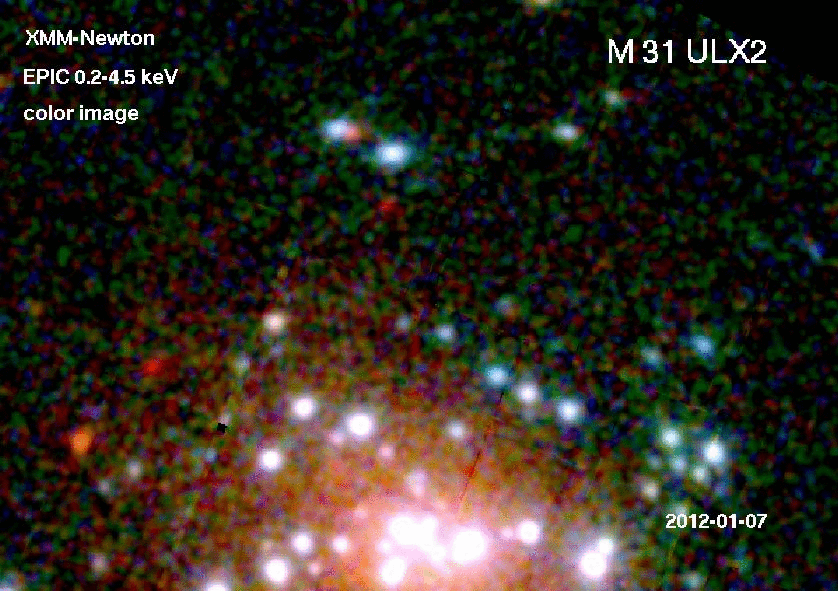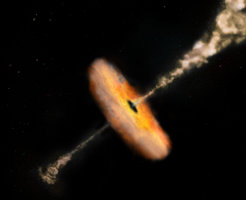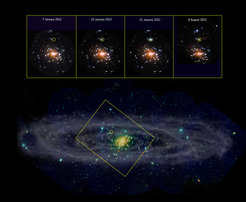Brilliant X-ray source in Andromeda galaxy identified as stellar mass microquasar

This animation shows the observations of the bright X-ray source XMMU J004243.6+412519 in our neighbouring Andromeda galaxy over the course of seven months. There are a number of other variable sources in this area, but only the ULX shows the extreme brightening in X-rays and the tell-tale radio signal of a jet of energetic particles ejected from the surroundings of the stellar mass black hole.
Black holes can’t be seen, as their extreme gravity swallows even light. However, if a black hole is accreting matter from its surroundings, the material will heat up and shine brightly in X-rays. This accretion disk around the black hole is often accompanied by powerful jets, outflows of highly energetic plasma powered by gravitational pull of the black hole, which emit a strong radio signal. Accretion discs and jets are two aspects of the same phenomenon and by studying their connection astronomers can investigate the physical mechanisms that take place close to a black hole.
An international team of astronomers from institutes in Germany, the UK and other countries have now analysed a particularly interesting source: An ultraluminous X-ray object (ULX) was discovered in January 2012 by a monitoring programme of the Andromeda galaxy led by Wolfgang Pietsch from the Max-Planck Institute for Extraterrestrial Physics. This is only the second ULX known in the Andromeda galaxy and it was immediately flagged for follow-up observations at radio wavelengths.

This illustration shows an artist's impression of XMMU J004243.6+412519, an X-ray binary system which consists of a stellar-mass black hole that is accreting matter from a low-mass companion star. The X-ray data and further observations at radio wavelengths suggest the transition to a higher mass accretion rate and the onset of radio jets – outflows of energetic particles that are launched from the vicinity of the black hole.
“These ultraluminous X-ray sources are very interesting for astronomers, as they can outshine even a whole galaxy in X-rays,” says Wolfgang Pietsch from the Max Planck Institute for Extraterrestrial Physics. “In this case, we saw not only the extreme brightening in X-rays but also a change in the spectrum, which indicates a change in the accretion rate of the black hole.”
The ULX was discovered in the framework of an X-ray monitoring programme designed to find and observe novae, binary star systems where a white dwarf star is accreting material from a companion. This leads to a nuclear explosion on the white dwarf’s surface and copious emission in soft X-rays – so far more than 75 novae have been discovered in Andromeda in the course of this programme. However, an interesting by-product is, as in this case, the detection of X-ray binaries, which host neutron stars or black holes and emit at much higher X-ray energies – up to the bright ULX.
Over the course of seven months, the astronomers tracked how the ULX brightened and faded dramatically. The data indicate that the black hole has been swallowing material from its surroundings close to or even exceeding the theoretical limit for spherical objects. Data from black holes that are accreting beyond this limit can help astronomers understand how the structure of the disc changes at such high accretion rates and, possibly, also what triggers the outflow of material from the vicinity of the black hole. And such an outflowing jet was indeed observed at radio wavelengths, the first time that radio jets have been detected from a stellar-mass black hole outside our own galaxy.

The sequence of images at the top depict the centre of Andromeda and were taken with XMM-Newton on four occasions during 2012. These images illustrate the discovery of a new source, XMMU J004243.6+412519 (highlighted with a circle).
"We watched a black hole work its way through an entire multi-course meal, from a light appetizer when the source was dim, gorging on a main course when really bright and then slowing down over dessert” says Matthew Middleton of the University of Durham. “And along the way it let off some steam in the form of jets, telling us that this ultraluminous X-ray source, and by extension, many others, is just a typical stellar remnant about ten times the mass of the sun, swallowing as much material as it possibly can."














